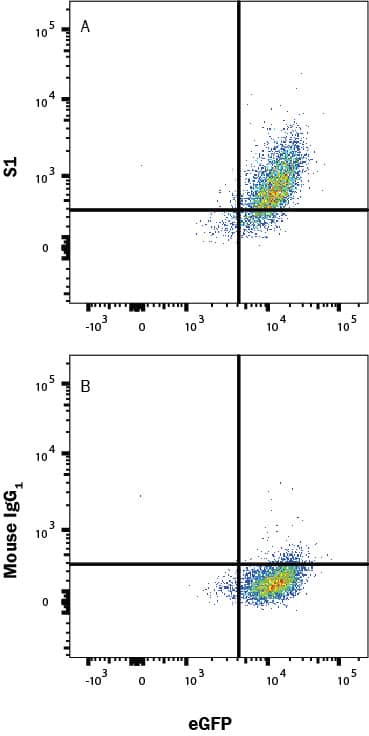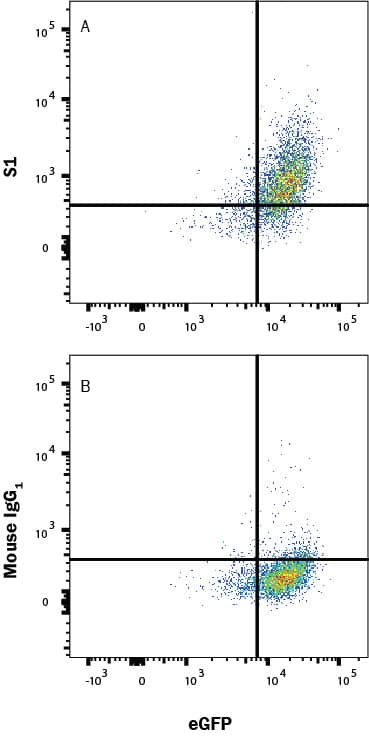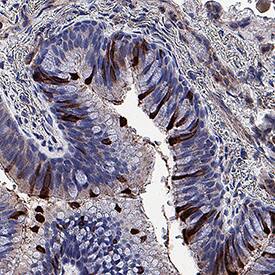SARS-CoV-2 Spike S1 Subunit Antibody Best Seller
R&D Systems, part of Bio-Techne | Catalog # MAB105403


Conjugate
Catalog #
Key Product Details
Species Reactivity
Validated:
SARS-CoV-2
Cited:
Human, Mouse, African Green Monkey, Chlorocebus aethiops (African Green Monkey)
Applications
Validated:
CyTOF-ready, Flow Cytometry, Immunohistochemistry, Western Blot
Cited:
IHC, In Vivo, Western Blot
Label
Unconjugated
Antibody Source
Monoclonal Mouse IgG1 Clone # 1035206
Product Summary for SARS-CoV-2 Spike S1 Subunit Antibody
Immunogen
HEK293-derived SARS-CoV-2 Spike S1 Subunit protein
Accession # YP_009724390.1
Accession # YP_009724390.1
Specificity
Detects SARS-CoV-2 Spike S1 subunit in direct ELISAs and Western blots. Detects SARS-CoV-2
B.1.1.529 S RBD (Omicron Variant) in direct ELISAs. No cross-reactivity with SARS-CoV-2 Spike RBD is observed in direct ELISAs or Western blots.
Clonality
Monoclonal
Host
Mouse
Isotype
IgG1
Scientific Data Images for SARS-CoV-2 Spike S1 Subunit Antibody
Detection of SARS-CoV-2 Spike S1 by Western Blot.
Western blot shows lysates of recombinant SARS-CoV-2 Spike S1 Subunit and recombinant SARS-CoV-2 Spike RBD. PVDF membrane was probed with 2 µg/mL of Mouse Anti-SARS-CoV-2 Spike S1 Monoclonal Antibody (Catalog # MAB105403) followed by HRP-conjugated Anti-Mouse IgG Secondary Antibody (HAF018). A specific band was detected for Spike S1 at approximately 90 kDa (as indicated). This experiment was conducted under reducing conditions and using Western Blot Buffer Group 1.Detection of SARS-CoV-2 Spike S1 protein bound to ACE-2 in live HEK293 Human Cell Line Transfected with Human ACE-2 and eGFP by Flow Cytometry.
HEK293 human embryonic kidney cell line transfected with human ACE-2 and eGFP was incubated with Recombinant SARS-CoV-2 Spike S1 Subunit His-Tag protein (10522-CV), then stained with (A) Mouse Anti-SARS-CoV-2 Spike S1 Monoclonal Antibody (Catalog # MAB105403) or (B) Mouse IgG1 Isotype Control Antibody (MAB002) followed by Allophycocyanin-conjugated Anti-Mouse IgG Secondary Antibody (F0101B). Staining was performed using our Staining Membrane-associated Proteins protocol.Detection of SARS-CoV-2 Spike S1 protein bound to ACE-2 in fixed HEK293 Human Cell Line Transfected with Human ACE-2 and eGFP by Flow Cytometry.
HEK293 human embryonic kidney cell line transfected with human ACE-2 and eGFP was incubated with Recombinant SARS-CoV-2 Spike S1 Subunit His-Tag protein (10522-CV), then stained with (A) Mouse Anti-SARS-CoV-2 Spike S1 Monoclonal Antibody (Catalog # MAB105403) or (B) Mouse IgG1 Isotype Control Antibody (MAB002) followed by Allophycocyanin-conjugated Anti-Mouse IgG Secondary Antibody (F0101B). Prior to staining, cells were fixed with Flow Cytometry Fixation Buffer (FC004). Staining was performed using our Staining Membrane-associated Proteins protocol.Applications for SARS-CoV-2 Spike S1 Subunit Antibody
Application
Recommended Usage
CyTOF-ready
Ready to be labeled using established conjugation methods. No BSA or other carrier proteins that could interfere with conjugation.
Flow Cytometry
0.25 µg/106 cells
Sample: SARS-CoV-2 Spike S1 protein bound to ACE-2 in live or fixed HEK293 Human Cell Line Transfected with Human ACE-2 and eGFP
Sample: SARS-CoV-2 Spike S1 protein bound to ACE-2 in live or fixed HEK293 Human Cell Line Transfected with Human ACE-2 and eGFP
Immunohistochemistry
5-25 µg/mL
Sample: Immersion fixed paraffin-embedded sections of SARS-CoV-2 infected human lung tissue and Human lung infected with SARS delta variant.
Sample: Immersion fixed paraffin-embedded sections of SARS-CoV-2 infected human lung tissue and Human lung infected with SARS delta variant.
Western Blot
2 µg/mL
Sample: Recombinant SARS-CoV-2 Spike S1
Sample: Recombinant SARS-CoV-2 Spike S1
Please Note: Optimal dilutions of this antibody should be experimentally determined.
Reviewed Applications
Read 1 review rated 5 using MAB105403 in the following applications:
Formulation, Preparation, and Storage
Purification
Protein A or G purified from hybridoma culture supernatant
Reconstitution
Reconstitute at 0.5 mg/mL in sterile PBS. For liquid material, refer to CoA for concentration.
Formulation
Lyophilized from a 0.2 μm filtered solution in PBS with Trehalose. *Small pack size (SP) is supplied either lyophilized or as a 0.2 µm filtered solution in PBS.
Shipping
The product is shipped at ambient temperature. Upon receipt, store it immediately at the temperature recommended below. *Small pack size (SP) is shipped with polar packs. Upon receipt, store it immediately at -20 to -70 °C
Stability & Storage
Use a manual defrost freezer and avoid repeated freeze-thaw cycles.
- 12 months from date of receipt, -20 to -70 °C as supplied.
- 1 month, 2 to 8 °C under sterile conditions after reconstitution.
- 6 months, -20 to -70 °C under sterile conditions after reconstitution.
Background: Spike S1 Subunit
References
- Wu, F. et al. (2020) Nature 579:265.
- Tortorici, M.A. and D. Veesler (2019). Adv. Virus Res. 105:93.
- Bosch, B.J. et al. (2003) J. Virol. 77:8801.
- Belouzard, S. et al. (2009) Proc. Natl. Acad. Sci. 106:5871.
- Millet, J.K. and G. R. Whittaker (2015) Virus Res. 202:120.
- Yuan, Y. et al. (2017) Nat. Commun. 8:15092.
- Walls, A.C. et al. (2010) Cell 180:281.
- Jiang, S. et al. (2020) Trends. Immunol. https://doi.org/10.1016/j.it.2020.03.007.
- Ortega, J.T. et al. (2020) EXCLI J. 19:410.
- Wrapp, D. et al. (2020) Science 367:1260.
- Tai, W. et al. (2020) Cell. Mol. Immunol. https://doi.org/10.1016/j.it.2020.03.007.
- Okba, N. M. A. et al. (2020). Emerg. Infect. Dis. https://doi.org/10.3201/eid2607.200841.
- Wang, X. et al. (2020) https://doi.org/10.1038/s41423-020-0424-9.
- Wang, K. et al. (2020) bioRxiv https://www.biorxiv.org/content/10.1101/2020.03.14.988345v1.
Long Name
Spike Protein, S1 Subunit
Alternate Names
SARS-CoV-2
UniProt
Additional Spike S1 Subunit Products
Product Documents for SARS-CoV-2 Spike S1 Subunit Antibody
Product Specific Notices for SARS-CoV-2 Spike S1 Subunit Antibody
For research use only
